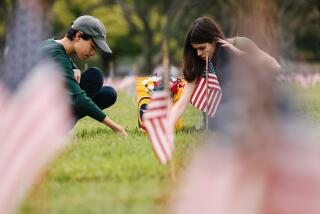O.C.âs Buried Civil War Vets Get Their Due
When Martin L. Osborn died, there was no one left to call.
The file at the old soldiersâ home listed a daughter as next of kin but included no street address. And Osbornâs wife of more than 50 years was already dead and buried in a Santa Ana cemetery.
So after cancer and pneumonia overwhelmed Osborn in 1929, at age 84, it was left to a Santa Ana veterans group to bury the Civil War veteran beside his wife in an unmarked grave.
Unmarked, that is, until now.
In a ceremony capped by a 21-gun salute, several dozen Civil War enthusiasts gathered earlier this month at Fairhaven Memorial Park for a second funeral for Osborn, this time placing a military headstone on his grave. It represents, they believe, the last unmarked grave among more than 700 Civil War veteran--mostly from the Union arm--buried in Orange County.
âHeâs been dead for 70 years and none of us knew this man, but we all came there to pay him a little bit of respect,â said Paul Gillette, a Garden Grove mail carrier and Naval Reservist who directed the project as a member of the Civil War Round Table. âI could not help thinking what that guy would be feeling if he was still alive and could see what kind of fuss was being made over him.â
At a time when most people are consumed by the present, it can be easy to lose track of the past. Easy to forget at the end of a war-torn century the conflicts of the previous century, and the people who fought them. People like Osborn, who suffered more injury as a farmer than as a soldier, and who fathered 10 children only to die with no apparent family.
Gillette and others hope to fight that tide of forgetfulness.
âThe idea is to refresh peopleâs awareness that the Civil War veterans who came here formed the core of the social, political and business life of [Santa Ana],â said former Mayor Gordon Bricken, an amateur historian who discovered Osbornâs unmarked grave during his own three-year project to catalog Santa Anaâs Civil War veterans. Some of those veterans even played a surprising part in the very birth of Orange County.
Gillette and other members of the Round Table, a group of Civil War history buffs that formed in 1997, based their research in part on Brickenâs work. The amateur historians compiled old lists of veterans drawn up by turn-of-the-century veterans groups, then matched the names against cemetery records and walked through cemeteries looking for headstones. In Osbornâs case, cemetery records noted his burial site, but there was no marker.
Gillette said the volunteers covered all of Orange Countyâs older cemeteries except for a small one in Brea, which they hope to canvass soon. He said they believe they have accounted for all the Civil War veterans.
California a Magnet for Civil War Vets
Three graves were discovered without headstones, which are provided free by the Veteransâ Administration. Two were those of Confederate soldiers; the Sons of Confederate Veterans placed headstones on those graves in October, Gillette said.
Last weekend, Osborn received his stone, about 1 by 2 feet and flush with the ground, bearing his name, date of death and military assignment.
The modest stone forms a tangible link to the past.
California had been a state for 11 years when the Civil War broke out in 1861, launching four years of savage military campaigns across the South. Some 620,000 soldiers died, more than half from disease. California was largely uninvolved in the war, but afterward the West Coast became a magnet for those seeking escape.
âThe South was in ruins. The North had the postwar problem of a huge labor force arriving, so unemployment was a problem,â said Lou Carlson, chaplain for the Orange County chapter of the Sons of Confederate Veterans. In addition to the veterans returning home, large numbers of freed slaves moved to the North after the war.
And in the West, former Confederates found that North-South distinctions mattered less.
âYou could get a fresh start,â said Carlson, a counselor at Fairhaven Cemetery. Some old habits died hard, though.
âVirtually all the leaders of the movement to secede from Los Angeles County [and create Orange County] in the 1880s were Confederate veterans,â said Bricken, who wants to assemble a guide book to the graves that would include brief biographies. The local secession movement was more successful; Orange County separated from Los Angeles in 1889.
Osborn, a Union veteran, was a relatively late arrival to Orange County. According to federal military records obtained by Gillette, Missouri-born Osborn volunteered at Fort Scott, Kan., on July 5, 1863, at age 18, enrolling as a private in the 2nd Kansas Volunteer Battery.
Osbornâs unit fought along the frontier in Arkansas, Kansas, Missouri and the Choctaw Nation. His role, though, remains murky. Records show he fell ill with dysentery in June and again in October of 1864, the second time hospitalized in Fort Smith, Ark. He was listed as a cook in the spring of 1865, and mustered out at Fort Leavenworth, Kan., on Aug. 11, 1865.
About three years later, the former soldie--5 feet 8 with brown hair and eye--married Catharine Strahan, a Kansas widow.
âShe was married to a man [who] went back down in Arkansas and got in trouble and was killed and then she went back home and then I and her was married,â Osborn wrote in a 1915 application for veteransâ benefits.
The couple lived in Kansas until 1874, then made their way West, settling in Camp Verde, Ariz., about 50 miles south of Flagstaff, in 1879. Osborn became a farmer and the couple raised their 10 children, four of whom died before reaching adulthood.
Osborn survived the war without wounds but didnât have the same luck in farming. Records show a neighbor beat him senseless with a shovel in June 1889 during a dispute over irrigation.
By 1919, when Osborn was 74, the couple were living in a house on West 6th Street in Santa Ana, near what is now Pacific Avenue. Catharine Osborn died of dysentery July 15, 1921, at age 72, and within a year her husband had moved out. He eventually entered the Pacific Branch of the National Home for Disabled Volunteer Soldiers in Los Angeles, the site of the current Veterans Administration hospital near Wilshire Boulevard and the San Diego Freeway.
Osbornâs death June 11, 1929, received a brief mention in what was then called the Santa Ana Register, which noted that Sedgwick Post #17 of the Grand Army of the Republic--founded by Union army veteran--would arrange the service. No survivors were listed, and the name of the daughter the hospital thought was Osbornâs next of kin was not included in the list of children Osborn himself wrote. Nothing is known of the whereabouts of Osbornâs children.
So the threads of Osbornâs life end with his death.
But picking up those threads in the first place, Gillette said, is part of the attraction of tracking the Civil War dead.
âItâs one of those things that the more you dig into the guy, the more questions you churn up,â Gillette said. âItâs been an amazing experience. Itâs taught me a lot not just about the Civil war, but about its relationship to Orange County.â
More to Read
Sign up for Essential California
The most important California stories and recommendations in your inbox every morning.
You may occasionally receive promotional content from the Los Angeles Times.











